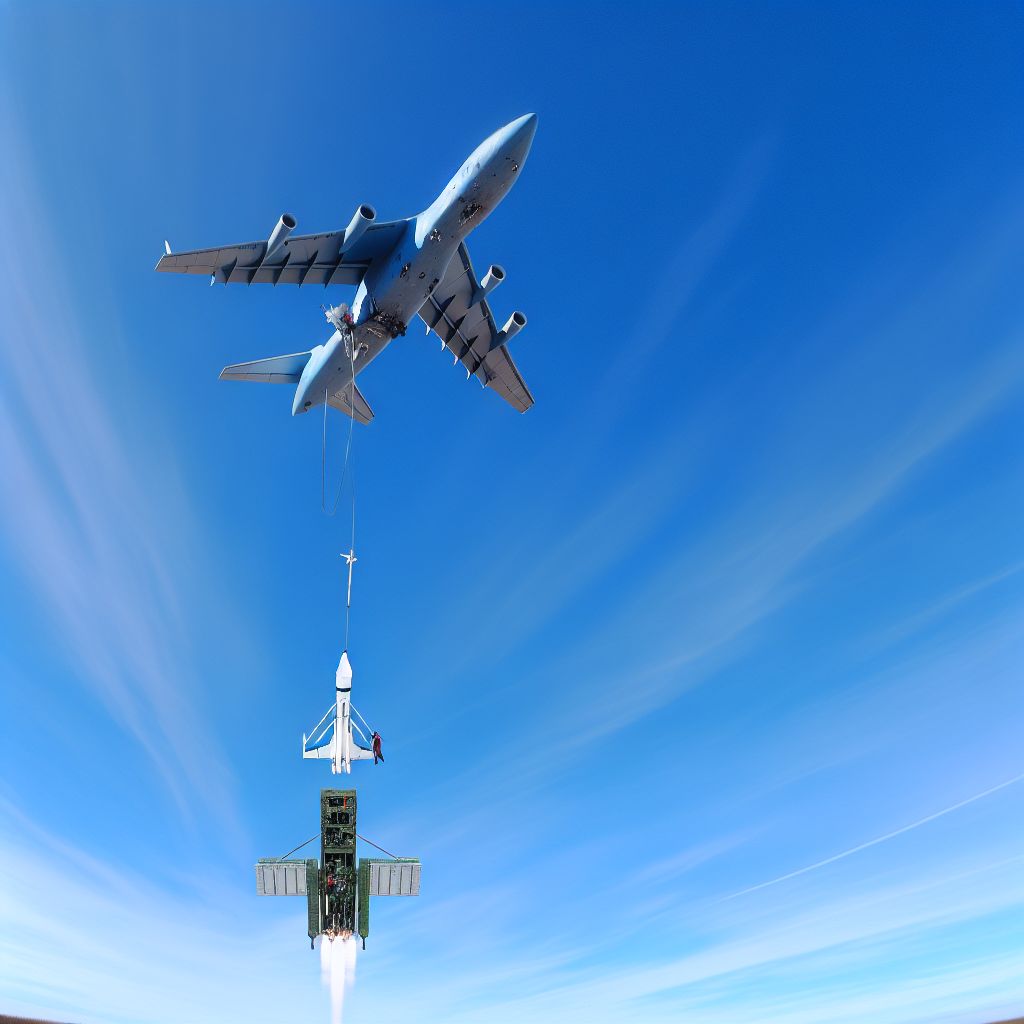In the Space industry context, "Air-launch" refers to a method of launching Spacecraft where the Launch Vehicle, carrying the satellite or spacecraft, is initially carried aloft by a larger carrier Aircraft. Once at a predetermined altitude, the launch vehicle is released from the carrier aircraft and ignites its engines to propel itself into Space. This method contrasts with traditional Ground-based launches, where the Rocket is launched directly from the Earth's surface.
General Description

Air-launch offers several advantages over traditional launch methods. It allows for more flexibility in launch locations and timings, as the carrier aircraft can avoid adverse weather conditions and fly to optimal launch points. This method can also lead to cost savings and increased efficiency, as it requires less Fuel to reach Orbit from the already elevated altitude and can utilize existing aircraft Technology and Infrastructure. Additionally, air-launch systems are considered to have a lower environmental impact, given the reduced need for large launch facilities and ground-based infrastructure.
Application Areas
- Satellite Deployment: Small satellites, particularly those destined for low Earth orbit (LEO), are ideal candidates for air-launch due to the method's cost-effectiveness and flexibility.
- Research Missions: Air-launch is used for scientific research missions that require specific launch conditions or trajectories not easily achievable from ground-based sites.
- Space Tourism: Some air-launch systems are being developed for suborbital space tourism, offering a unique method for space travel.
Risks and Challenges
Despite its advantages, air-launch faces challenges, including the limitations on the size and Weight of the Payload due to the carrying capacity of the carrier aircraft. There are also technical and safety challenges related to the release and Ignition of the launch vehicle at high altitudes. Ensuring the reliability and safety of air-launch systems requires extensive testing and certification processes.
Summary
Air-launch represents a flexible, cost-effective, and innovative method of accessing space, offering significant benefits for satellite deployment, research missions, and potential applications in space tourism. Despite facing specific challenges, the Development of air-launch technology continues to advance, promising to play a significant role in the future of space exploration and the commercial space industry.
--
Related Articles to the term 'Air-launch' | |
| 'Troposphere' | ■■■■■■■■ |
| Troposphere: In the aerospace context, the troposphere is the lowest layer of the Earth\'s atmosphere. . . . Read More | |
| 'Launch Vehicle' | ■■■■■■■■ |
| Launch Vehicle in the space industry refers to a rocket or spacecraft specifically designed to propel . . . Read More | |
| 'Boosting' | ■■■■■■■■ |
| Boosting refers to the use of additional propulsion to increase the speed or altitude of a spacecraft . . . Read More | |
| 'Launcher' | ■■■■■■■ |
| A launcher is a device or system used to launch or propel an object into the air or into space. Launchers . . . Read More | |
| 'Carrier' | ■■■■■■■ |
| Carrier: A carrier can refer to a number of different things, depending on the context. Some possible . . . Read More | |
| 'Propulsion' | ■■■■■■■ |
| Propulsion is the generation of force to launch an object, which is typically a rocket. . . . Read More | |
| 'SpaceShipTwo' | ■■■■■■■ |
| SpaceShipTwo in the space industry context refers to a suborbital, air-launched spaceplane developed . . . Read More | |
| 'LauncherOne' | ■■■■■■■ |
| Deutsch: / Español: LauncherOne / Português: LauncherOne / Français: LauncherOne / Italiano: LauncherOne . . . Read More | |
| 'Launch' | ■■■■■■■ |
| Launch: A launch is the first part of the flight of a rocket when it leaves the ground for orbital spaceflights, . . . Read More | |
| 'Ground' | ■■■■■■■ |
| Ground is the solid surface of the Earth (not covered by water). . . . Read More | |
